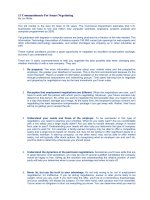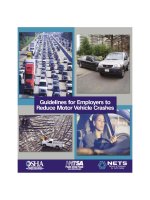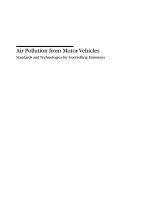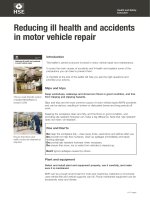Motor vehicle repair Good practice for SMART sprayers docx
Bạn đang xem bản rút gọn của tài liệu. Xem và tải ngay bản đầy đủ của tài liệu tại đây (581.54 KB, 10 trang )
Health and Safety
Executive
Motor vehicle repair
Good practice for SMART sprayers
Introduction
This guide for SMART (small and medium-area repair technique) repair sprayers
describes how you can adequately control risks to health, safety and the
environment. It was prepared by a working group of industry and government
representatives (including the Health and Safety Executive (HSE)) to represent
‘good control practice’ as defined under the Control of Substances Hazardous to
Health Regulations 2002 (COSHH), as amended. The working group members and
their affiliation are listed at the back of this leaflet.
The guide tells you what is, and is not, permitted in SMART repairs by sprayers
who have no fixed place of work. It is also useful for franchisees, managers and
operators in motor vehicle dealership or repair who manage, carry out or
commission SMART repair. It is in addition to existing guidance for spraying in
motor vehicle repair, using spray booths and spray rooms. See the motor vehicle
repair section of the HSE website.
1
You may conclude, through COSHH assessments, that different controls apply in
your circumstances. You will need to record any such conclusions.
Important:
❋ The sprayer should wear respiratory protective equipment.
❋ Keep other people away from spray mist.
Figure 1
1 of 10 pages
Health and Safety
Executive
Characteristics of SMART spraying
SMART spraying is the spray application of a surface coating to parts of motor
vehicles, usually outside a spray booth or spray room. The parts coated, as part of
a
repair, should not extend to a complete panel or panels.
Typically, spraying is by:
❋ a mini-spray gun or airbrush, which would normally have an inlet pressure up to
2 bar, delivering a volume of air much less than 150 l/min and a fluid flow well
below 100 g/min; or
❋ a pre-packaged aerosol spray can.
This guidance does not cover application by the use of a brush or roller.
Paints include surface coatings that are dried or cured by UV light, chemical
hardeners or other means.
The quantity of paint sprayed is unlikely to exceed 25 ml per coat. The time spent
spraying paint is unlikely to exceed 1 minute per coat, although the spray job may
take a few minutes.
Figure 2
Spray coatings – a summary of the hazards and risks
SMART spraying products
SMART spraying products are reactive – one-pack products, or two-pack products
that require mixing before use. The products may be solvent-based or water-
based.
The health risks depend on the chemistry, but for ‘reactive’ products:
❋ isocyanate-based products (including water-based isocyanate products) may
cause asthma and dermatitis;
Motor vehicle repair: Good practice for SMART sprayers
2 of 10 pages
Health and Safety
Executive
❋ UV-curable products may cause dermatitis – and may contain isocyanate;
❋ other products (eg acid-cured) may cause effects at least as serious as
solvent-based products, including irritation of eyes, nose and throat, and mild
reversible effects on the body.
Conventional spraying products
Conventional spraying products are solvent-based, commonly known as ‘cellulose
paints’. Their use in SMART spraying is reducing.
The health risks from spraying typically include irritation of eyes, nose and throat,
and mild reversible effects on the body.
Safety and environmental hazards
Products used in spraying are usually flammable or highly flammable. They require
safe storage. The small quantities of products used in SMART spraying mean that
any fire risk is likely to be within 15 cm of the sprayer nozzle.
The environmental hazards are volatile organic compounds (VOCs) that create
ground-level ozone in summer, and groundwater pollution if disposed of incorrectly.
The Volatile Organic Compounds in Paints, Varnishes and Vehicle Refinishing
Products Regulations 2005 mean that you will not be able to get products
containing higher concentrations of VOCs (and existing stocks should have been
used up by January 2008).
Grey market products
Grey market products are those acquired through non-conventional networks, eg
personal import or military surplus. In these cases, information on the product may
be in a foreign language, sparse or absent. Avoid using such products.
Control of risks
Personal protective equipment (PPE)
You should wear respiratory and skin protection when SMART spraying with
reactive products.
Respirator
❋ You need suitable respiratory protective equipment (RPE).
❋ If you use isocyanate-based products, you must wear air-fed RPE.
❋ Suitable air-fed RPE means having an assigned protection factor (APF) of 20 or
higher, ie:
- LDM2 air-fed half-mask; or
- LDH3 air-fed visor.
❋ Filtering RPE is not suitable.
Suppliers of RPE for spraying will provide equipment that meets the LDH3 or LDM2
specification.
Motor vehicle repair: Good practice for SMART sprayers
3 of 10 pages
Health and Safety
Executive
Figure 3 Air-fed half-mask Figure 4 Air-fed visor Figure 5 Filtering RPE for non-
reactive products
The compressor must deliver enough clean air for the respirator to work properly.
Stop the breathing air supply getting contaminated by keeping the compressor and
its air intake upwind or outside of the spray area and clear of other harmful
substances.
It is good practice to use the same types of PPE when spraying with non-reactive
products. However, half-mask filtering RPE with an assigned protection factor (APF)
of 10 or higher can be used instead of air-fed RPE, and disposable RPE is
acceptable.
RPE has to fit and work properly every time it is worn. Fit testing and training in use
and maintenance may be provided by the RPE supplier or by training
organisations.
RPE testing and maintenance:
❋ Check that there is a good flow of clean air to your respirator every time you
put RPE on. Air-fed visor RPE should have low-flow alarms.
❋ At least once a week, check that the compressor and air lines are in good
condition and that the filters and traps are clean. Record these checks in a log
book, with details of any parts replaced (eg exhalation valves for half-mask
respirators, face seals for visors).
❋ BS EN 529:2005
2
proposes that the volume flow and quality of the supplied air
should be thoroughly tested at intervals as specified by a competent person
after risk assessment. With good records, and confidence in the air quality, you
may only need to check the airflow and air quality once or twice a year.
Other PPE
❋ If you use a half-mask respirator, you may also need chemical protective
goggles.
❋ Use overalls of any material, with a hood.
❋ Use single-use gloves. Nitrile gloves are suitable. If you have to use latex
gloves, select ‘low protein powder-free’ gloves. Single-use gloves are
disposable – throw them away after each spray application.
Motor vehicle repair: Good practice for SMART sprayers
4 of 10 pages
Health and Safety
Executive
Figure 6 Chemical protective goggles
Figure 7 Protective gloves
Location of spraying
You need to prevent unprotected people being exposed to spray.
Spraying indoors
❋ Keep everyone without air-fed RPE out of the room during your work.
❋ Make sure there are no ignition sources.
❋ Wear all PPE for gun priming, spraying and gun cleaning.
❋ Keep wearing your RPE until you have left the room.
Even when using a spray booth, spray room or capture unit, sprayers still need to
wear air-fed RPE and PPE, and bystanders should be excluded when using
isocyanate-based products. The duty is to control exposure to isocyanates to as
low as is reasonably practicable. The need for health surveillance still applies.
Once spraying has finished, the sprayer should leave the spray booth, room or
area wearing the RPE. For isocyanates, re-entry before the clearance time (booth
or room) or before 30 minutes (workshop) have elapsed requires air-fed RPE. This
always applies.
Mist capture and filtration equipment requires annual thorough maintenance,
examination and test.
Spray booth (oven) or spray room
Use a small smoke machine to fill with smoke. Measure the time it takes to clear.
Mark this clearance time on the doors. Guidance on selecting a smoke machine
can be found in
Party fog machines suitable for measuring clearance time: review
3
and clearance time method.
Figure 8
Motor vehicle repair: Good practice for SMART sprayers
5 of 10 pages
Health and Safety
Executive
Workshop
Use an extract ventilation unit to capture and filter over-spray and mist. You need
to place the unit very close to the sprayed surface. Some units are ineffective at
capturing spray: check with a smoke machine. Containment equipment (that
actively catches the majority of over-spray) and spray enclosures (that contain,
remove and filter overspray) are commercially available.
Spraying outdoors
Ensure the compressor and its air intake are upwind of spraying and clear of other
harmful substances.
Keep anyone without air-fed RPE a minimum of 5 but preferably 10 metres away
from spraying. At this distance, there is minimal health risk.
Wear all PPE for gun priming, spraying and gun cleaning. Keep wearing your RPE
until the job – and gun cleaning – is finished.
Figure 9
Waste disposal
Decontaminate wipes, wastes and empty paint containers before disposal.
Decontamination recipes should appear in Part 6 of the product Safety Data Sheet.
For isocyanate-based products, you can use a solution of washing soda in water
(50 g per litre) and leave it to stand for a few days to decontaminate.
Dispose of waste solvent, decontaminated residues and containers, gloves etc as
hazardous waste. You must not dispose of them in domestic waste.
Other risks
❋ Cleaning the spray gun with thinner, then spraying dry, produces the same
hazards as spraying paint. Use the same controls as for spraying.
❋ Cleaning your hands with thinners can cause dermatitis. Use suitable skin-
cleaning products.
Motor vehicle repair: Good practice for SMART sprayers
6 of 10 pages
Health and Safety
Executive
❋ UV lamps produce radiation that is harmful to the eyes and exposed skin.
Control the risk – keep everyone away from UV lamps, and arrange screens to
stop reflected light.
❋ Test electrical equipment (ie portable electrical appliance (PAT) testing) regularly
(eg once a year).
❋ The compressor is a ‘pressure system’, so you need to have the compressor
reservoir examined regularly. Your insurance company can advise you on how
often (eg once a year).
❋ Carry a fire extinguisher containing carbon dioxide or dry powder. Replace it
when it reaches its expiry date. Exclude ignition sources (eg no smoking, naked
flames or grinding wheels) while spraying.
❋ Keep out of traffic routes and away from moving vehicles. For work in car parks
or on public roads, wear a high-visibility vest over your overalls.
❋ Secure safe access for working at height. A tower scaffold is preferable to a
ladder. Never work from the top of your van.
Administrative controls
Health surveillance
There is a chance of dermatitis developing with all reactive products, and of
asthma developing with isocyanate-based paints. If you become sensitised, leading
to dermatitis or asthma, you may never be able to work with paint products again.
You should provide health surveillance for your employees to check for signs of
dermatitis and, for those using isocyanates, asthma. If you are self-employed, you
are advised to undergo health surveillance.
Signs of ill health
Dermatitis:
❋ skin redness or soreness;
❋ itching;
❋ rash;
❋ skin cracking or peeling.
Asthma:
❋ recurring sore or watering eyes;
❋ recurring blocked or running nose;
❋ bouts of coughing;
❋ chest tightness;
❋ wheezing;
❋ history of persistent chest problems.
Seek advice from an occupational health professional (eg doctor or nurse). Look in
the
Yellow Pages etc under ‘Health and safety consultants’ and ‘Health authorities
and services’. See also www.nhsplus.nhs.uk. Your trade association may be able
to help you find an occupational health professional.
Storage
Keep the quantities of stored paint products to a minimum. If other SMART
products contain peroxides (eg activators for polyester resins used with fillers or
fibreglass), these must be kept apart and stored in a sealed metal container.
Motor vehicle repair: Good practice for SMART sprayers
7 of 10 pages
Health and Safety
Executive
Record keeping
If
you are self-employed or an employer with five employees or fewer, you don’t
need to write a separate health and safety risk assessment, although it is useful so
that you can review it at a later date, eg if something changes.
This document can act as your COSHH assessment, and you simply need to keep
records to show that you are following it.
Testing
Keep written records of:
❋ RPE testing;
❋ testing the compressor reservoir air filters;
❋ health surveillance; and
❋ disposal of hazardous wastes.
These records should be available for inspection.
Training and competence
SMART sprayers should be trained to:
❋ use equipment, RPE and products safely;
❋ maintain equipment and RPE;
❋ understand the hazards and risks, and how to control them;
❋ recognise the signs of ill health, and what to do about them; and
❋ decontaminate and dispose of waste properly.
SMART sprayers should be able to provide evidence of training from their
franchiser, product supplier or professional training provider.
There are some common misperceptions about isocyanates:
These are false These are true
Isocyanates contain cyanide that
poisons you.
Isocyanate doesn’t contain cyanide.
Isocyanates cause cancer. Isocyanates cause asthma.
Isocyanates get into the body
thr
ough thin skin, eg around the
eyes.
Isocyanates get into the body by
breathing in mists.
Isocyanates can cause asthma in
I’m safe – there’s no history of
anyone who is exposed. Smoking
asthma in my family.
makes developing asthma more
likely.
My paint doesn’t contain Auto paints are ‘dangerous for
isocyanate, so it is perfectly safe. supply’. Read the safety data sheet!
Motor vehicle repair: Good practice for SMART sprayers
8 of 10 pages
Health and Safety
Executive
Legal provisions – test requirements
COSHH assessment
This document can act as your COSHH assessment as long as:
❋ it is suitable for your operations and you follow all the points;
❋ you maintain and test your RPE;
❋ where necessary, you carry out health surveillance; and
❋ you keep records of maintenance, examinations and all tests.
Spray booth, room and over-spray/mist control units
These require regular checks for signs of wear and to show that they are working
properly. They also require thorough examination and test at least once every
14 months.
You need to measure and display the clearance time of spray booths and spray
rooms.
Respiratory protective equipment
This requires thorough examination and test at least once every three months. The
quality of air supplied to breathing apparatus should be checked periodically. Keep
the filters and water traps clean.
Other health and safety law
You need to have pressure and electrical systems tested, and keep records of
these tests.
Environment law
The Environmental Protection Act 1990 applies with regard to statutory nuisance
(section 80). However, mobile operators will rarely stay at a single location long
enough to satisfy the criteria for statutory nuisance. If the operation is at defined
premises, eg a supermarket car park or at a residential or commercial address,
action could be taken against the owner or occupier of the land. There are also
requirements under this legislation for the correct disposal of waste.
The Pollution Prevention and Control Act 1999 does not apply, because SMART
repairers are unlikely to exceed the thresholds of 1.0 tonnes (cars) and 0.5 tonnes
(trailers) per annum of solvent that requires a permit. There is currently no provision
in the Pollution Prevention and Control Regulations 2000 to require mobile
installations of this type to have permits.
References and further reading
1 HSE’s motor vehicle repair website: www.hse.gov.uk/mvr/index.htm
2 BS EN 529:2005
Respiratory protective devices. Recommendations for
selection, use, care and maintenance. Guidance document
British Standards
Institution
3
Party fog machines suitable for measuring clearance time: review and
clearance time method www.hse.gov.uk/research/hsl_pdf/2006/hsl0643.pdf report
reference HSL/2006/43
Motor vehicle repair: Good practice for SMART sprayers
9 of 10 pages
Health and Safety
Executive
Five steps to risk assessment Leaflet INDG163(rev2) HSE Books 2006 (single copy
free or priced packs of 10 ISBN 978 0 7176 6189 3)
www.hse.gov.uk/pubns/indg163.pdf
Membership of working group and affiliation
Andrew Garrod Health and Safety Executive
Andrew Lake Health and Safety Executive
Andy Glass Spraybooth Technology Ltd
Andy Manns Health and Safety Executive
Bob Attlee GlassAid(GB) Ltd
Colm Mcilvenny Smart Wise
Doug Kirk Junair Group
Hugh Williams British Coatings Federation (BCF)
Ian Davison R H Patterson & Co Ltd
Ian Lewis The Motor Insurance Repair Research Centre (Thatcham)
Ian Taylor Independent Consultant
John Highfield Ashford International
John Morecroft Vehicle Builders and Repairers Association (VBRA)
Mark Hooker Solihull MBC
Mark Piney Health and Safety Executive
Mike Battrick Akzo Nobel
Mike Bolton Independent SMART repairer
Nick Bicknell ChipsAway
Peter Barlow Retail Motor Industry Federation (RMIF)
Philip Preece Birmingham City Council
Rob Ward AutoRestore
Steve Barrett Smart Express
Steve Faulkner Dent Wizard International
Wil Miller GlassAid (GB) Ltd
Matthew Coldwell Health and Safety Laboratory
Further information
HSE priced and free publications are available by mail order from HSE Books,
PO Box 1999, Sudbury, Suffolk CO10 2WA Tel: 01787 881165 Fax: 01787 313995
Website: www.hsebooks.co.uk (HSE priced publications are also available from
bookshops and free leaflets can be downloaded from HSE’s website:
www.hse.gov.uk.)
For information about health and safety ring HSE’s Infoline Tel: 0845 345 0055
Fax: 0845 408 9566 Textphone: 0845 408 9577 e-mail: or
write to HSE Information Services, Caerphilly Business Park, Caerphilly CF83 3GG.
This document contains notes on good practice which are not compulsory
but which you may find helpful in considering what you need to do.
This document is available web-only at: www.hse.gov.uk/pubns/web33.pdf.
©
Crown copyright This publication may be freely reproduced, except for
advertising, endorsement or commercial purposes. First published 10/07. Please
acknowledge the source as HSE.
Published by the Health and Safety Executive Web33 10/07
10 of 10 pages









